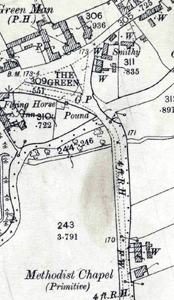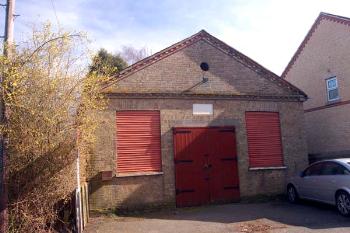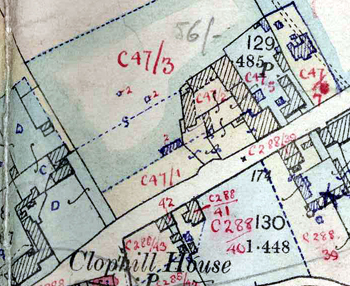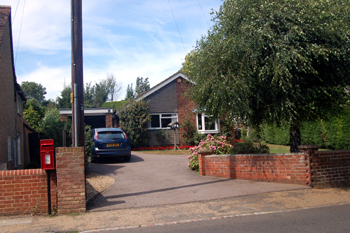Primitive Methodism in Clophill

The Primitive Methodist chapel shown on an Ordnance Survey map of 1901
Methodism was founded by John Wesley in 1740 but a number of splinter groups broke away from the movement during the next century. Mainstream Methodism became known as Wesleyan Methodism and remained quite close to the Low Church Anglican style of worship, though with a completely different structure. Primitive Methodism, which emerged in 1811, was a much more fundamentalist strain in which local groups of churches exercised more autonomy than in the Wesleyan church and in which the laity did more of the decision making.
The first evidence of Primitive Methodists in Clophill comes in the Ecclesiastical Census of 1851. The results of this were compiled by David W. Bushby and published as part of Bedfordshire Historical Record Society volume 54 in 1975. The census sought to find the numbers attending places of worship on one particular Sunday, 30th March 1851. The Primitive Methodists were then meeting in "A house hired exclusively for preaching" which could seat a hundred people and the congregation had been in existence since 1846. That afternoon fifty people attended, with eighty in the evening. This was up on the averages for the preceding twelve months which had been forty and seventy. John Mossman, "agent for the Revd. John Parrott" noted: "Prayer Meeting is regularly held every Sabbath morning and occasionally in week days".

The former Primitive Methodist chapel in Old Silsoe Road in March 2007 (now demolished)
In 1853 a Primitive Methodist chapel in Luton Road (now Old Silsoe Road) was registered by John Symonds Gostling of Bedford, upholsterer. This building was still standing in 2007 but by 2010 had been demolished. The chapel formed part of the Bedford Mission (Hull Circuit) until 1867, then the Bedford Primitive Methodist Circuit until 1897, when it became part of the Bedford II Circuit, later called the Cauldwell Street Circuit. The two strands came back together in the early twentieth century and were instrumental in establishing the Methodist Church of Great Britain in 1932. Six years later the Clophill Wesleyan Chapel (which was actually in Maulden) was united with the Primitive congregation and the Wesleyan building demolished. A new chapel in the High Street was built by the former Wesleyan congregation, opening in February 1938. In March 1938 the former Primitive congregation put their chapel up for sale, preparatory to moving in with the former Wesleyans.
The chapel sold by the former Primitive congregation in 1938 was not the little chapel in Luton Road. Bedfordshire and Luton Archives and Records Service has a deed of gift of 1920 in which Henry Upton, late of Ampthill, now of Maulden, farmer, conveyed a small piece of ground fifteen feet square as part of the site for a Primitive Methodist chapel and schoolroom to trustees for the nominal sum of ten shillings [MB1384]. The land was a small part of High Street Meadow. The trustees were: Alfred Garner of Clophill, journeyman miller; James Bone of Clophill, marker gardener; Henry Garner of Clophill, carman; William Langley of Clophill, horse keeper; Walter George Garner of Clophill, insurance agent; Ernest Matthews of Clophill, gardener; Frank Gobey of Clophill, labourer; John Smith of Clophill, grocer; Alfred Coleman of Silsoe, horse keeper and Herbert Hills of Flitwick coachman. The superintendent minister was Richard Newman Wycherley. The deed is endorsed with the following: "This is a copy and relates to the site of the old Primitive Methodist Chapel which was sold and converted into a bungalow. It is of no value and merely of interest for information".
Confirmation that this was not the old chapel comes in the form of the assessments carried out in conjunction with the Rating and Valuation Act 1925. The act specified that every piece of land and building in the country was to be valued to determine its rateable value. Clophill was assessed in 1927 and the valuer visiting the old chapel found it owned and occupied by H. Butcher [DV1/C288/93]. The premises was now used as a tea house. It was described as a brick and slate detached building 27 feet 6 inches square with a tea room, store and kitchen. Outside stood a weather-boarded and slated earth closet and a weather-boarded and concrete shed. The valuer commented: "Used to be Methodist Chapel".

The position of the Primitive Methodist chapel in 1927
The new chapel was in the position shown above (top right hand corner) and indicated by the annotation C47/7. The valuer noted that it was constructed of stucco and asbestos tiles and stood on 0.145 of an acre. In addition to the chapel itself there were two weather-boarded and felt earth closets and a weather-boarded and felt barn. The site of the chapel is today [2010] a bungalow numbered 55 High Street.
 55 High Street - site of the former Primitive Methodist chapel - July 2010
55 High Street - site of the former Primitive Methodist chapel - July 2010